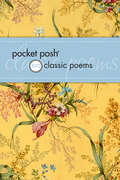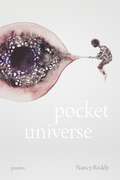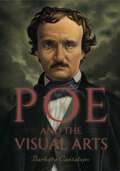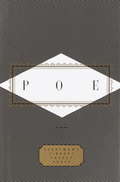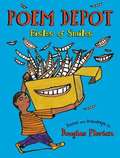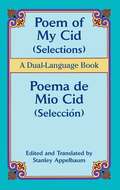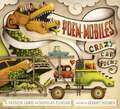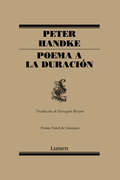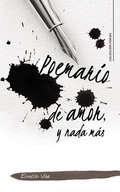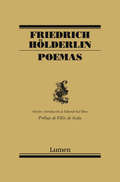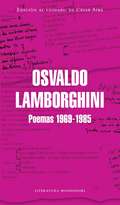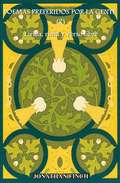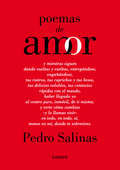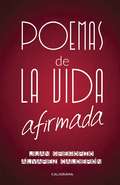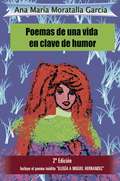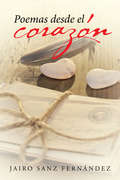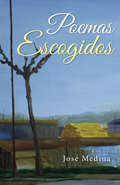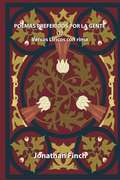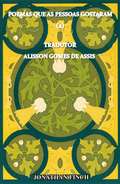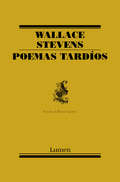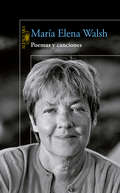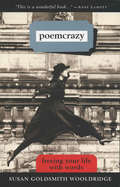- Table View
- List View
Pocket Posh 100 Classic Poems
by Jennifer FoxDiscover how a little poetry can lift your spirits and inspire your life, with selections from Yeats, Byron, Poe, Dickinson, and other greats.Including William Blake’s “The Tyger,” Emily Dickinson’s “Hope Is the Thing with Feathers,” William Wordsworth’s “The World Is Too Much with Us,” John Keats’s “A Thing of Beauty” (from “Endymion”), and ninety-six more, this collection of classic poems allows you to spend a few moments each day with timeless verses.Escape the noise and experience a taste of Walt Whitman, Alfred Tennyson, Henry Wadsworth Longfellow, William Butler Yeats, Emily Bronte, Amy Lowell, Christina Rossetti, Ralph Waldo Emerson, Elizabeth Barrett Browning, Edgar Allan Poe, Sara Teasdale, Lord Byron, and many more.
Pocket Universe: Poems
by Nancy ReddyNancy Reddy’s Pocket Universe explores how the world becomes more wondrous and more perilous in the permanent after of parenthood. The collection begins in the public hospitals in sixteenth-century Paris—where women giving birth were as likely to die of fever as go home with healthy newborns—travels through the dizzying world of Instamommies and celebrities who effortlessly got their body “back” after baby, and ends with children singing at a bounce-house birthday party. Poems set those intimate, ostensibly domestic matters against weighty questions about human origins, our place in the universe, and the pervasive historical and present-day violence against mothers and children.Pocket Universe traces an arc from the challenges and bodily horror of the first weeks home with a new baby, through the wonder of watching that child discover the world, and finally to the hard-won joy of motherhood.
Poe and the Visual Arts
by Barbara CantalupoAlthough Edgar Allan Poe is most often identified with stories of horror and fear, there is an unrecognized and even forgotten side to the writer. He was a self-declared lover of beauty who “from childhood’s hour . . . [had] not seen / As others saw.” Poe and the Visual Arts is the first comprehensive study of how Poe’s work relates to the visual culture of his time. It reveals his “deep worship of all beauty,” which resounded in his earliest writing and never entirely faded, despite the demands of his commercial writing career. Barbara Cantalupo examines the ways in which Poe integrated visual art into sketches, tales, and literary criticism, paying close attention to the sculptures and paintings he saw in books, magazines, and museums while living in Philadelphia and New York from 1838 until his death in 1849. She argues that Poe’s sensitivity to visual media gave his writing a distinctive “graphicality” and shows how, despite his association with the macabre, his enduring love of beauty and knowledge of the visual arts richly informed his corpus.
Poe and the Visual Arts (G - Reference, Information and Interdisciplinary Subjects)
by Barbara CantalupoAlthough Edgar Allan Poe is most often identified with stories of horror and fear, there is an unrecognized and even forgotten side to the writer. He was a self-declared lover of beauty who “from childhood’s hour . . . [had] not seen / As others saw.” Poe and the Visual Arts is the first comprehensive study of how Poe’s work relates to the visual culture of his time. It reveals his “deep worship of all beauty,” which resounded in his earliest writing and never entirely faded, despite the demands of his commercial writing career. Barbara Cantalupo examines the ways in which Poe integrated visual art into sketches, tales, and literary criticism, paying close attention to the sculptures and paintings he saw in books, magazines, and museums while living in Philadelphia and New York from 1838 until his death in 1849. She argues that Poe’s sensitivity to visual media gave his writing a distinctive “graphicality” and shows how, despite his association with the macabre, his enduring love of beauty and knowledge of the visual arts richly informed his corpus.
Poe: Poems
by Edgar Allan PoePoe's poems have been memorized and recited by millions. Among his best-loved works are "The Raven" with its hypnotic chant of "nevermore, " and the sensuous and lyrical "Annabel Lee." This collection includes all of Poe's most popular rhymes.
Poem Depot
by Douglas FlorianIn the vein of Shel Silverstein and Jack Prelutsky, this illustrated book of humorous poems will guarantee giggles Artist, poet, and award-winning author Douglas Florian successfully captures the comedy of kids' everyday lives with this jam-packed volume of 170 nonsense poems. Meander through the different aisles--such as "Jests & Jives" or "Tons of Puns"--to find everything from laugh-out-loud limericks to frenetic free verse. With Florian's eccentric wit and off-the-wall drawings, this one-stop funny poetry shop is perfect for fans of Where the Sidewalk Ends.
Poem of My Cid (Selections) / Poema de Mio Cid (Selección): A Dual-Language Book
by Stanley AppelbaumThe Poema de Mio Cid recounts the adventures of Rodrigo Diaz, an 11th-century hero of Islamic Spain. The Cid and his legendary exploits were already the subjects of ballads, songs, and children's tales by the time of this 12th-century epic poem. The sole dual-language edition currently available.
Poem-mobiles: Crazy Car Poems
by Douglas Florian J. Patrick LewisThis paperback picture book features fresh, quirky poems by two picture-book poetry veterans which explore practically every kid's favorite topic: CARS!The U.S. Children's Poet Laureate and an award-winning children's poet join their prolific forces in this picture book of poems about cars. But they're not just any cars: there's the "Sloppy-Floppy-Nonstop-Jalopy" ("So unique there is no copy"); the Bathtub Limosine ("With hot water heating / And porcelain seating"); and the "High Heel Car." Each of the thirteen quirky, inventive poems will speak directly to the imaginations of children, as will Holmes's high-concept, detail-filled illustrations.
Poema a la duración
by Peter HandkeEl libro de poemas más emblemático de Peter Handke, premio Nobel de literatura 2019. Peter Handke publicó Poema a la duración en 1986, el mismo año en que apareció su novela La repetición, con la que de alguna manera se relaciona. Lírico y épico a un tiempo, narrativo y filosófico, este poema largo explora la duración como algo que, a diferencia de la noción metafísica de la eternidad, se manifiesta en la irrupción súbita de algo que vuelve, arrastrándonos en el tiempo y dándonos la sensación de que en la vida humana hay una unidad interna muy fuerte y a la vez completamente desconocida. Canto a la fugacidad y al movimiento incesante de la vida, Poema a la duración es una obra maestra del género que aquí publicamos en la extraordinaria y ya clásica versión de Eustaquio Barjau. Reseñas:«Por un trabajo influyente que, con inventiva lingüística, ha explorado las periferias y la especificidadde la experiencia humana.»Jurado del Premio Nobel «Si tuviera que elegir entre toda su bibliografía, optaría por Poema a la duración. En él se encuentra condensado todo su pensamiento poético-filosófico. [...] Handke busca el instante ya no como los poetas de otros tiempos a través de objetos puros, sagrados, sino a través de los profanos, de los cotidianos, de los restos de lo que fue abolido. Handke construye su propia cosmogonía a base de los fragmentos sueltos que deja el tiempo arqueológico que es uno y todo.»César Antonio Molina, ABC «No es solo su mejor trabajo poético, sino una de las cimas de toda su carrera literaria. [...] La duración es su enseña, el distintivo de una vida a la que, durante un instante, le es concedido el don de verse perpetuada.»Luis Muñiz, La Nueva España «Tiene algo de ensayo, algo de narración, y ese "algo" distinto que constituye la originalidad de la mirada de Handke: una extrañeza a la hora de comenzar el libro que casi siempre perdura al acabarlo, pero que se queda pegada a la retina como una nueva forma de mirar.»Librería La Central
Poemario de amor, y nada más
by Elnolla ViseEs un canto de amor a la mujer. Desnudo y limpio. Cuarenta y cuatro poemas de amor. Un fabuloso tributo a la mujer. El amor universal desde una poesía sencilla y limpia. Emociones, desatadas y libres, con un ritmo y musicalidad sensacional que las hace únicas. Un poemario con personalidad propia.
Poemas
by Friedrich HölderlinHölderlin pertenece a la restringida familia de los grandes escritores de todos los tiempos, aquella en la que podríamos incluir a Píndaro, Dante, San Juan y Shakespeare, y no tiene rival en la modernidad. Su poesía escapa a cualquier clasificación, por mucho que a veces se le incluya entre los románticos, de cuyo espíritu participa pero a quienes supera para explorar un territorio en el que se entreveran la poesía, la filosofía, el mundo clásico y una espiritualidad heterodoxa. En esta traducción, Eduardo Gil Bera se ha atrevido con el canon esencia de Hölderlin, un total de 95 poemas. Por todo lo dicho, este libro no es uno más dentro de la colección de poesía, sino uno de sus títulos señeros, sin duda el más importante del año.El prólogo corre a cargo de Félix de Azúa, gran estudioso de Hölderlin.
Poemas (edición bilingüe)
by Friederich HölderlinUna nueva y extraordinaria traducción del gran poeta alemán. «Los poetas son vasos sagradosdonde se custodia el vino de la vida,el espíritu de los héroes.» Junto a Píndaro, Dante o Shakespeare, Hölderlin pertenece a la restringida familia de los grandes cantores de todos los tiempos. La insondable belleza de sus poemas alcanza una trascendencia que rebasa los límites del movimiento romántico en que se gestaron, adentrándose así en un territorio indómito en el que se entreveran la poesía, la filosofía, el mundo clásico y la espiritualidad. El presente volumen, extraordinariamente traducido por Eduardo Gil Bera, reúne el corpus esencial de la poesía de juventud y madurez del poeta de Suabia, desde las grandes odas hasta las elegías y los himnos, incluido «El archipiélago», uno de los grandes hitos de la poesía universal. Como recuerda Félix de Azúa en su iluminador prólogo, en estos poemas, a pesar de la oscuridad circundante, aúlla un inmenso sí a la vida.
Poemas 1969-1985: Edición al cuidado de César Aira
by Osvaldo LamborghiniEl poeta frente a su cuaderno con su caligrafía. Lamborghini vuelve realcomo ningún otro ese acto a la vez doméstico y perturbador. Gracias a César Aira, este libro reúne la obra poética de OsvaldoLamborghini. No es probable que uno pueda encontrar en la poesíaargentina de las últimas décadas una obra más consistente. A lainusitada y singular coherencia temática -que incorpora mitologíaspersonales y dosis de poesía política, de psicoanálisis, de gauchesca,del surrealismo mejor asimilado- hay que añadirle la búsqueda formal deun escritor atento siempre a las inflexiones orales y a su propagación ycombinación en la página.Desobediente a todo y a todos, el autor encuentra el poema "unadesgracia pasajera" y lo convierte en un arma secreta. O lo somete a unaviolencia textual que poco tiene en común con las transgresiones delos escandalizadores profesionales.Ante esa materialidad a la vez suficiente y escasa, ante la repeticiónabstraída, el que escribe debe reaccionar cada vez de manera distinta.Para desconcertar, para prever un lector único al final de la oscuridad,para no encontrar la señal de consentimiento del «hombre de letras».Generoso, fatal, imprescindible, Lamborghini se nos presenta comoepítome y adalid del poeta solo para inventarse en un más allá muypróximo -el encabalgamiento que falta- la identidad socarrona del quelee, entre líneas, esa carta de amor/odio que solo el estilo haceposible. Una carta definitiva.
Poemas Preferidos Por La Gente
by Jonathan Finch Rodolfo Alejandro Parada PintoUna colección de poemas previamente publicados. Todos los poemas en "Poemas Preferidos Por La Gente (2)" han sido publicados en antologías y pequeñas revistas dentro de el Reino Unido.
Poemas de amor
by Pedro SalinasDe entre todos lo grandes poetas de la generación del 27, Pedro Salinas ha pasado a la historia como el poeta del amor, especialmente por el ciclo amoroso compuesto por los títulos La voz a ti debida, Razón de amor y Largo lamento. La grácil y honda ligereza de su voz, la lucidez a la hora de describir el tiempo amoroso y la belleza y memorabilidad de sus imágenes le han convertido en uno de los poetas más leídos y queridos del siglo XX. El presente libro constituye una amplia antología de sus mejores poemas amorosos, desde sus primeros hasta sus últimos libros, un verdadero monumento de la lengua.
Poemas de amor
by Pedro SalinasUna amplia antología de la mejor poesía amorosa de Pedro Salinas. De entre todos los grandes poetas de la generación del 27, Pedro Salinas ha pasado a la historia como el poeta del amor, especialmente por el ciclo amoroso compuesto por los títulos La voz a ti debida, Razón de amor y Largo lamento. La grácil y honda ligereza de su voz, la lucidez a la hora de describir el tiempo amoroso y la belleza y memorabilidad de sus imágenes le han convertido en uno de los poetas más leídos y queridos del siglo XX. El presente libro constituye una amplia antología de sus mejores poemas amorosos, desde sus primeros hasta sus últimos libros, un verdadero monumento de la lengua.
Poemas de la vida afirmada
by Juan Gregorio Álvarez CalderónPoesía vitalista tanto mundana como filosófica. Este poemario, en el que predominan las poesías con métrica y rima tradicionales (destacando la presencia de sonetos), trata de comunicar una actitud de celebración de la vida y de afirmación de su valor con esporádicas expresiones contrastantes. <P><P>La temática es amplia y va desde lo pornográfico hasta lo filosófico, pasando por lo religioso, la transmisión de experiencias autobiográficas y el planteamiento de las contradicciones vitales e ideológicas del autor. <P>Predomina aquí lo conceptual expresivo sobre la búsqueda de meros efectos verbales imaginativos y sobre el recrearse en la experiencia de la extrañeza y el descentramiento propios de un vanguardismo ya agotado. <P>Más allá de valores formales, este poemario tiene valor como expresión de una subjetividad diversificada en sus intereses y actitudes.
Poemas de una vida en clave de humor
by Ana María Moratalla GarcíaPoesía de humor, solidaridad y desgarradoras emociones, el mundo necesita remover sus cimientos para asentar la libertad a través del arte y siempre con una sonrisa. <P><P>Este libro nos invita a iniciar un poético recorrido por el Universo de la autora, es un viaje autobiográfico, cargado de volcánicas emociones y profundas experiencias. <P><P> Su inspiración nos sumergirá en un Multiverso de espejos reflectantes de la esencia humana, en constante reivindicación por recuperar el paraíso perdido. Es un canto de alabanza a la vida en todas sus facetas, cifrado en clave de humor.
Poemas desde el corazón
by Jairo Sanz FernándezLEE, SUEÑA Y SIÉNTETE VIVO. Lee y disfruta de sentimientos, sueños y pensamientos que seguro te llevaran a momentos únicos e inolvidables.
Poemas escogidos
by José MedinaEl libro que tienes en tus manos recopila los avatares de una vida desesperada en continua busca de una realidad nunca encontrada. <P><P>El autor describe con cierta crudeza los momentos vividos entre los sueños y la realidad, no siempre sabiendo qué lado tiene más peso en la narración. <P><P> Los momentos oníricos se mezclan con las vivencias de una forma que no es fácil discernir cuál es cuál y que el autor no pretende que se pueda hacer, tal vez, ni él mismo sepa hacerlo. Puede que todo se encuentre sentado en un rincón del desván de su cerebro.
Poemas preferidos por la gente: Versos líricos con rima
by Jonathan FinchUna colección de poemas convencionalmente publicados en antologías, folletos y pequeñas revistas, muchos de los cuales recibieron un elogio especial.
Poemas que as pessoas gostaram
by Jonathan FinchEsse é o segundo livro da série "Poemas que as pessoas gostaram". Os poemas foram previamente publicados principalmente em pequenas revistas. Selecionados por editores independentes, alguns foram muito comentados. Eles são dedicados para pessoas que não se sentem livres e para os expatriados em todo o mundo. Assim como no primeiro volume, os poemas exploram a natureza, a mortalidade, a emoção, a criatividade, a prisão, os desvios e aparelhagem sem fim. Eles trabalham com palavras nos lugares certos, as quais tentam criar sentido numa confusa série de experiências conflitantes, em um mundo onde os pretos, os brancos e os cinzas realmente se misturam entre si e com as cores do nascer e pôr do sol mesmo quando desconcertantemente conflitantes, onde o tempo de um dia é realmente uma miscelânea a ser recriada de forma bela, o poeta espera. Os poemas são divididos em duas partes. A parte A é "O veneno que leva ao suicídio" e a parte B é "Vivendo". A parte A trata dos impulsos suicídas e emoções negativas muito afloradas, enquanto que a parte B lida com a vida "normal".
Poemas tardíos
by Wallace StevensÚltimo poemario de uno de los grandes poetas norteamericanos del siglo XX. Cuando Wallace Stevens murió en 1955, parecía que toda su obra estaba ya publicada y cerrada, pero en realidad quedaban una serie de poemas sueltos, escritos en sus últimos años, que nunca se habían recopilado en libro alguno. Estos Poemas tardíos, traducidos ahora por primera vez íntegramente al castellano, conforman una de las despedidas poéticas más intensas, originales y turbadoras del siglo XX. Lejos de ser una mera dispersión, este libro es el complemento a La roca, en puridad el último poemario de Stevens. Como allí, el poeta escribe cercado por la muerte, enfrentado a su propia imagen espectral. Y lo más extraordinario es que Stevens no se permite la repetición sino que indaga en un nuevo camino y conforma una de las experiencias poéticas más rotundas y osadas de su tiempo. Como ya hiciera en La roca, Daniel Aguirre nos ofrece una versión excelente de estos últimos poemas de Stevens, en los que «el caballo camina hasta casa sin jinete / con la cabeza baja».
Poemas y canciones
by María Elena WalshPoemas y canciones, canciones y poemas. «...pero eso sí: vería con agrado que alguien reconociera en un espejo mi ser a duras penas dibujado. Que alguien compadecido no sé dónde sintiera que mi voz le corresponde.» Poemas que se hacen canción para mejor quedar en el oído y anidar para siempre en la memoria de todos. Canciones que son vidalas, zambas, chamamés, pero también endechas españolas, valses centroeuropeos o danzas del barroco; ritmos asimilados por un oído finísimo y devueltos al mundo en letras tan personales como significativas. Poemas de riguroso lirismo en sus primeros libros, y luego "hechos a mano", "pura conversación a mi manera", como los describió la misma María Elena, subjetivos o colectivos, íntimos, humorísticos, críticos. Poemas y canciones, canciones y poemas. Siempre versos de poeta: delicados, agudos, profundos y humanísimos.
Poemcrazy
by Susan G. WooldridgeFollowing the success of several recent inspirational and practical books for would-be writers, Poemcrazy is a perfect guide for everyone who ever wanted to write a poem but was afraid to try. Writing workshop leader Susan Wooldridge shows how to think, use one's senses, and practice exercises that will make poems more likely to happen.From the Hardcover edition.
